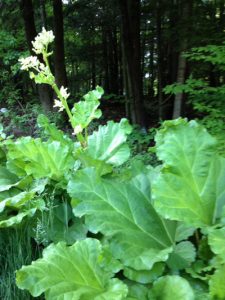Maine Home Garden News — June 2014
- June Is the Month to . . .
- The Old and Now New Methods of Pest Control in the Garden
- What You May Like to Know About Honey Bees
- Environmentally Sound Gardening Tips
- Brae Maple Farm Project Embodies Gardening’s Social Benefits
- Food & Nutrition: Washing Fresh Fruits and Vegetables
By Richard Brzozowski, Extension Educator, University of Maine Cooperative Extension Cumberland County, richard.brzozowski@maine.edu
- Remove rhubarb seed heads. Simply clip the shoots near the base with a sharp knife or scissors and remove them from the growing area.
- Take precautionary measures for tender transplants if frost is in the forecast. The threat of frost has probably passed but you still need to keep an eye on the weather forecasts.
- If you have not done so already, there is still time to plant your vegetable garden. If time and space are a premium for you, consider growing a few low maintenance or “goof proof” vegetables like summer squash or pole beans.
- Try growing a specialty variety of potatoes, like colored-skin or fingerling-types. For more information about growing potatoes in the home garden and ways to prepare them see Bulletin #2077, Growing Potatoes in the Home Garden and Bulletin #4179, Vegetables and Fruits for Health: Potatoes.
- Compost! Compostable materials like grass clippings, leaves, and kitchen food scraps can be gathered and merely piled or a structure can be used. For more information on composting, see Bulletin #1143, Home Composting or check out our other many composting resources.
- Visit your favorite garden center to see and learn about the latest plant materials and gardening tools and other related products.
- Learn more about ticks and Lyme Disease. See Bulletin #2357, Lyme Disease or visit UMaine Extension’s Tick ID Lab website.
- Prepare for any gardening problems you faced last growing season. Was it an insect, disease, weed or a species of wildlife? Perform some detective work before this same pest shows up this season. UMaine Extension has an insect and plant disease diagnostic lab with personnel who specialize in identifying and solving problems. For more information, see the Insect and Plant Disease Diagnostic Lab website.
- Establish a lawn. Establishing a lawn successfully takes some planning. For information and “how to” videos, see Bulletin #2367, Establishing a Home Lawn in Maine.
- Visit the gardens of others. The options include public gardens, organized garden tours, and the gardens of your friends or neighbors. When visiting, snap photos and take notes of things you find interesting. The 6th annual Backyard Locavore Day on August 9th is a unique educational event held in Cumberland County.
-
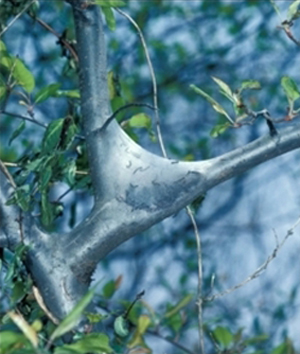
Eastern Tent Caterpillar nest. Photo by J. F. Dill. Remove Eastern Tent Caterpillar nests from fruit and landscape trees. Tent caterpillars typically set up camp in crotches of main branches. You can remove nests easily with a gloved hand or stick. No pesticides are necessary if you place the nest into a plastic bag and step on the bag several times to kill the caterpillars. Smaller nests are easier to remove than larger nests. Watch for any re-infestation as the season progresses. For more information, see Fact Sheet #5022, Forest and Eastern Tent Caterpillars.
- Watch for first signs of slugs (slime trails) and any damage caused by these mollusks. Slugs are a perennial pest in the gardens when the weather is wet. Iron phosphate is an effective natural control. Read and follow the label directions. For more information, see Fact Sheet 5036, Slugs.
The Old and Now New Methods of Pest Control in the Garden
By Barbara Murphy, Extension Educator, University of Maine Cooperative Extension Oxford County, barbara.murphy@maine.edu
In May, gardening is still a joy — both weeds and garden pests aren’t yet an issue and the garden still looks clean and full of possibilities. At least half the month is black fly free; life doesn’t get much better than that!
From June on, however, the story can be quite different. The warmer day and soil temperatures spur both plant and pest growth. Before you surrender your cucumbers to squash bugs or broccoli to cabbage worms, here is a suggestion that may help you protect your plants long enough to actually get to harvest.
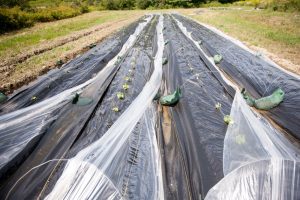 Floating Row Cover — This spun-polyester material (like thick tissue or interfacing) is readily available and comes in different weights. All weights of cover act like a greenhouse and raise the temperature under the cover, increasing plant growth. Heavier weights provide more frost protection; while lighter weights protect from light frosts, they are especially good as a barrier to flying pests. I use the lightweight type on almost all of my crops so that plants get established more quickly, or, in the case of a slow germinating crop like carrots, the intensity of rain is diminished before it hits the ground and dislodges the seed. Even more important than these benefits, I use row cover to keep many of the most prolific pests at bay. For example, the broccoli and cabbage that are currently in the ground have been covered since planting. I have wire hoops every five feet down the row to support the fabric that is weighted down with used, plastic wood pellet bags filled with sand. Since neither broccoli nor cabbage need to be pollinated, the cover can stay on the whole season, thus preventing the imported cabbage butterfly from laying eggs on the crop. This is the dreaded pest that produces the green caterpillars that blend in so masterfully with the veins on the leaves that it is hard to detect them until you notice copious amounts of frass (poop) or that part of the plant is missing.
Floating Row Cover — This spun-polyester material (like thick tissue or interfacing) is readily available and comes in different weights. All weights of cover act like a greenhouse and raise the temperature under the cover, increasing plant growth. Heavier weights provide more frost protection; while lighter weights protect from light frosts, they are especially good as a barrier to flying pests. I use the lightweight type on almost all of my crops so that plants get established more quickly, or, in the case of a slow germinating crop like carrots, the intensity of rain is diminished before it hits the ground and dislodges the seed. Even more important than these benefits, I use row cover to keep many of the most prolific pests at bay. For example, the broccoli and cabbage that are currently in the ground have been covered since planting. I have wire hoops every five feet down the row to support the fabric that is weighted down with used, plastic wood pellet bags filled with sand. Since neither broccoli nor cabbage need to be pollinated, the cover can stay on the whole season, thus preventing the imported cabbage butterfly from laying eggs on the crop. This is the dreaded pest that produces the green caterpillars that blend in so masterfully with the veins on the leaves that it is hard to detect them until you notice copious amounts of frass (poop) or that part of the plant is missing.
Floating row cover is also helpful in minimizing squash and cucumber beetle damage while the seedlings are young. Once again, cover the crops at planting. However, since all members of the squash family of plants require pollination (although types that don’t need pollination are starting to appear on the market), the cover needs to be removed once flowers appear on some plants. After that, it is up to you to provide control. The cover just allows the seedlings enough time to get up and established.
So, what to do once the covers have to be removed? Nothing is foolproof, so I try to keep an arsenal of tools available. First off, the electrified tennis rackets. Yes, you laugh, but these cheap bug zappers are delightfully efficient at frying squash bugs, Japanese beetles, cucumber beetles, as well as mosquitoes! I have found early in the morning, while it is still cool, is the best time to hover over the plants and swing wildly. I must admit it is very satisfying to hear the bugs being zapped.
Finally, after row cover and tennis rackets, I use a hand vacuum. For small bugs such as cucumber beetles, a strong vacuum works wonders. The type I have has an attachment that focuses the suction to a smaller area — perfect for sticking down squash blossoms!
So, in addition to scouting for eggs (continuously look under leaves), I use all of the above techniques to help me have a successful harvest. I would like to say that as a result my gardens are pest free, but what fun would that be?
What You May Like to Know About Honey Bees
By Ana Bonstedt, Home Horticulture Coordinator at UMaine Extension Piscataquis County

The honey bee has the largest worldwide distribution of all bee species. Honey bees survive and perpetuate in a unit called a colony. There are three different types of individuals in the colony: one queen, thousands of workers, and hundreds of drones. The colony is a fascinating community where each type has a special function.
The Queen Bee
The queen is the only sexually mature female in the colony and therefore the mother of all workers and most of the drones. Born from a fertilized egg, she is the result of a heavily royal jelly diet, which is a secretion produced by worker bees during the 15 days of their adult life and is used in the nutrition of larvae. A queen bee lives an average of three years and only leaves the hive for her mating flights, which usually take place between the sixth and tenth day after birth. Her only function is to lay eggs, which amount to approximately 2,000 per day. Attendant workers who surround the queen feed her and collect her waste. Additionally, the workers distribute her pheromone to inhibit the workers from starting queen cells and keep the colony together.
The Worker Bee
Worker bees are infertile females born from fertilized eggs and fed with a combination of royal jelly, pollen, and honey. The life span of a worker bee is 50 days, but during the winter they can live longer. The worker bees perform different tasks during their lifetime: through specialized glands located in the abdomen, they produce wax, which will be used to form the honeycomb, they suck nectar from flowers for energy, and they carry water when the hive is in danger of overheating. They also collect pollen for proteins and collect propolis, which is a resinous mixture from tree buds, sap flows or other botanical sources for sanitizing and to seal the cracks of the hive. Worker bees protect the colony against intruders even sacrificing themselves to achieve their goal.
The Drones
Drones are males born from infertile eggs. Their life span is about 3 months and their main purpose is to fertilize a new queen. The stronger drones will join with the queen in a special mating flight. After copulation, the drone dies because his reproductive organ and abdominal tissues, which are connected, are ripped from his body when he separates from the queen.
Drones do not collect nectar or pollen, but they help control the hive temperature by producing heat through shivering, or exhaust heat by moving air with their wings. They distribute the food among the workers, but when food is limited the worker bees force the drones out, letting them to die of cold and hunger outside the hive.
For more information about bees, see Bulletin #7153, Understanding Native Bees, the Great Pollinators: Enhancing Their Habitat in Maine.
Environmentally Sound Gardening Tips
By Richard Brzozowski, Extension Educator, University of Maine Cooperative Extension Cumberland County, richard.brzozowski@maine.edu
Everything that you do in your garden can influence the environment. Be a sound gardener by following these tips:
- Incorporate organic matter in the soil every year. Organic matter conditions the soil. It aids in holding water, holding nutrients, and encourages life underground (earth worms). Organic matter sources include farm manures, compost, seaweed, peat moss, leaves, grass clippings, etc.
- Use mulch. Mulch conserves moisture, controls weeds, keeps fruit and vegetables clean, provides a nice pathway for the gardener, and can be tilled under (if organic).
- Have the soil tested every 2-3 years. Soil testing provides you with the information to make wise gardening decisions regarding fertilizers, lime, and organic matter.
http://youtu.be/NA7GTuXS0pU
- Do not over work the soil. Over cultivation can destroy soil structure. Do not work wet or frozen soil. Raised bed gardens can be a method for early gardens if wet soil is a problem.
- Maintain a proper soil pH. Improper soil pH can “lock up” nutrients. Aim for a pH of 6.5 – 7.0
- Use soaker hoses or drip irrigation. Water only those plants that need it. Overhead sprinklers tend to waste water, wet the leaves, and cause disease problems.
- Keep soil covered in every season. The soil is a precious resource. Prevent soil erosion with crops, winter cover crops or mulch in the spring, summer, fall, and winter.
- Plant on the contour. Don’t allow water to take away the topsoil. Plant across the incline to catch any soil that moves downhill. Plant vegetative buffer strips to capture excessive nutrients and eroding soil.
- Use pesticides only when needed. Identify the pest that bugging your plants. Make a wise decision on timing, prevention, and control. Ask for advice if needed.
- Choose the least toxic control for the target pest. All pesticides are poisons (organic and synthetic). Select the pesticide that is meant for the pest and the plant you are trying to protect. Read the label before purchasing or using the product.
- Avoid over use of fertilizer. Too much fertilizer means pollution of the environment. Apply only those nutrients in the right amounts and at the best time for good garden yields.
- Compost to recycle nutrients. Composting is a great gardening practice that will recycle nutrients and benefit the soil. Composting also reduces the waste stream.
- Select crops / plants for your area. Use those plants that are suited for your specific area (hardiness zone and season length). Know what those plants need for growth, productivity, and survival.
- Use plants that naturally repel pests. Find out what pests are common for the crops you are growing. Use trap crops and companion plants to help keep pest populations low.
Brae Maple Farm Project Embodies Gardening’s Social Benefits
By Carol Gardner, Master Gardener Volunteer, Lincoln County
Some people are drawn to the solitude of gardening. But as a social activity, gardening can be equally rewarding. Maybe the only thing more gratifying than growing one’s own food is working with others to grow food for those in need.
Now in its 16th year, Brae Maple Farm’s Master Gardener Volunteer project embodies the social benefits of gardening. At the farm, volunteers grow between 1,500 and 2,000 pounds of fresh produce for local food pantries each year. But there’s an educational mission, too: members cultivate experimental and demonstration gardens of all sorts and share what they’ve learned.
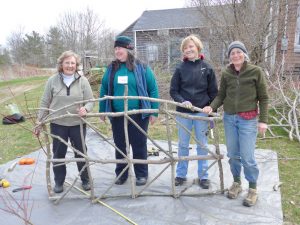
Over the years, the volunteers have cultivated traditional row crops; raised beds; a three sisters garden, a Native America method of planting corn, beans and squash together; edible weeds; and a lasagna garden, which features a layered composting approach to creating new soil. They’ve experimented with rain barrel irrigation. They’ve carried out an experiment for the University of Maine to find the best means of staking tomato plants, and they’ve performed trials for Johnny’s Selected Seeds to discover the best basil cultivars. They’ve held tastings for the public with up to 50 varieties of tomatoes and peppers. On a recent spring day, they held a class to teach new Master Gardeners how to build arbors and trellises using twigs and saplings. And each year on Open Farm Day, they entertain and educate as many as 450 visitors to Brae Maple Farm.
A love of gardening and a desire to help others attracted many of the members. But camaraderie has kept them together. “The people keep me with it,” says Pat Gibbons, a founding member who led the group for 15 years. That sentiment is echoed by members and observers.
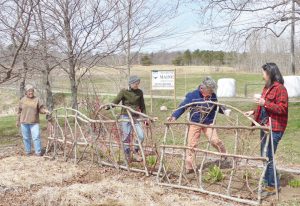
Andrea and Allan Smith host the project at their property, Brae Maple Farm in Union, Maine. The Smiths stay busy with their own operation, growing MOFGA-certified organic vegetables, herbs, and dried flowers, raising cattle, and selling crafts. Still, says Andrea, who purchased the property with her husband Allan in 1981, “Hosting the Master Gardener Volunteers is the best thing we’ve done since we’ve had the farm. It’s a nice group. It gives us a chance to give back, and having them here makes me stop and smell the roses.”
In 1998, a University of Maine Cooperative Extension educator approached the Smiths and asked if the Master Gardener Volunteer program could use a small part of their farm. The Smiths agreed, and soon after, both Andrea and Allan took the training themselves, which consists of 40 classroom hours in growing fruits and vegetables; basic botany, soil health, composting, and integrated pest management, delivered by Extension educators and specialists.
Today, Brae Maple Farm’s Master Gardener Project counts more than 20 participants. According to UMaine Extension Professor Mark Hutchinson, “Brae Maple is the longest ongoing Master Gardener Volunteer project in Knox and Lincoln Counties.”

The group meets at Brae Maple every Tuesday at 7:30 a.m. from the end of April through the first frost. And after they complete their chores, they share snacks prepared by one or two of the members.
Liz Stanley, Horticulture Program Coordinator for Knox-Lincoln and Waldo Extension, provides support to the group, and understands the social ties that knit them together. “The success of the Brae Maple Master Gardeners’ group is that they plan carefully at the end and beginning of each season—and they make it a celebration.” A recent planning breakfast featured an amazing spread of dishes prepared by the members themselves: sticky buns, blueberry pancakes, fruit salads, chipped beef, muffins, biscuits, and a dozen other items. But it also demonstrated the volunteers’ willingness to get things done, and to share ideas. One member showed off a box she had designed and constructed for taking the group’s produce to food pantries. Another showed a solitary bee house she had made for attracting pollinators to the garden. Two members offered to bring their cultivators for opening day. Others volunteered to map out plans for the project’s garden beds.
The Brae Maple project supports Maine Harvest for Hunger, which facilitates donations of freshly grown produce to food-insecure families and individuals throughout Maine. Their produce is donated to three local food pantries: Area Interfaith Outreach Food Pantry and St. Bernard’s Parish Hall Soup Kitchen in Rockland, and the Mid-Coast Hospitality House, a homeless shelter in Rockport. “We focus not only on the best ways of growing vegetables and fruit,” says volunteer Peter Marckoon, who delivers the produce, “but also on how to use them. So the food we donate to pantries is often accompanied by recipes and ideas on how to use it.”
A lifelong gardener, Jamie Doubleday is one of the newer members of the Brae Maple group, drawn in by the mission: “Our mission is a good one: feeding people. There’s nothing more basic than that.” But she adds that the sociability of those involved makes it stimulating and fun. “This is a great group of people. We work together in summer, but we also get together through the winter to eat, talk, and make crafts.”
Gibbons, one of three original members still with the group, believes that sharing ideas has been a large part of the program’s success and longevity: “People have answers for each other when it comes to gardening problems. We benefit from one another’s knowledge.”
Eliza Bailey, the group’s co-chair, has been with the Brae Maple Project for two years. “The group started as a demonstration project for aspiring gardeners,” she said. “And we still offer ideas. This year, we’re planting beds using three different types of mulch so that people can see what might work best for them.” But she adds that the group members benefit equally: “the amount of learning that goes on among us every week is amazing.”
Individuals and garden groups throughout Maine can grow food for the hungry. To find out more about Maine Harvest for Hunger and how you can help, go to UMaine Extension’s website: https://umaine.edu/harvest-for-hunger/. For information on becoming a Master Gardener Volunteer, visit https://extension.umaine.edu/gardening/master-gardeners/. Brae Maple Farm and its Master Gardener Volunteer Project will host visitors on Open Farm Day on Sunday, July 27. It is located at 233 North Union Road, Union, ME 04862.
Food and Nutrition
Washing Fresh Fruits and Vegetables
By Kate Yerxa, MS, RD, Statewide Nutrition and Physical Activity Educator, University of Maine Cooperative Extension, kate.yerxa@maine.edu
Fruits and vegetables are key parts of a healthful diet. To make sure you are not putting yourself at risk for food-borne illness, it is important wash all fruits and vegetables well before cutting, peeling, cooking or eating.
Washing fresh produce requires more effort than simply spraying lightly with tap water. Below are the steps you should take to thoroughly wash fruits and vegetables.
- Wash your hands for 20 seconds with soap and hot water before and after preparing food.
- Start with a clean counter, clean knife, and cutting board.
- Use drinkable, cold water to wash fruits and vegetables.
- Soaking fresh fruits and vegetables in water for one to two minutes can help to reduce the risk of food-borne illness.
- For produce with a thick skin, use a vegetable brush to help scrub away dirt.
- For fragile produce, like berries, use a colander and spray with water.
- After washing, dry with clean paper towel. This can remove more bacteria.
For leafy greens, wash greens by separating leaves and soaking them in a bowl of cool water for a few minutes. Drain the greens using a strainer or colander and repeat this process. Once the leafy greens are drained, dry with a clean towel or salad spinner. Salad spinners should be thoroughly cleaned with warm soapy water after every use.
For more information, see Bulletin #4336, Best Ways to Wash Fruits and Vegetables.
For information about storing fresh garden produce, visit the resources available at https://extension.umaine.edu/gardening/home-gardening/vegetables/.
Information in this article adapted from University of Maine Cooperative Extension Bulletin #4336, Best Ways to Wash Fruits and Vegetables.
University of Maine Cooperative Extension’s Maine Home Garden News is designed to equip home gardeners with practical, timely information.
Let us know if you would like to be notified when new issues are posted. To receive e-mail notifications fill out our online form.
Contact Lois Elwell at lois.elwell@maine.edu or 1.800.287.1471 (in Maine).
Visit our Archives to see past issues.
Maine Home Garden Newswas created in response to a continued increase in requests for information on gardening and includes timely and seasonal tips, as well as research-based articles on all aspects of gardening. Articles are written by UMaine Extension specialists, educators, and horticulture professionals, as well as Master Gardener Volunteers from around Maine, with Professor Richard Brzozowski serving as editor.
Information in this publication is provided purely for educational purposes. No responsibility is assumed for any problems associated with the use of products or services mentioned. No endorsement of products or companies is intended, nor is criticism of unnamed products or companies implied.
© 2014
Call 800.287.0274 or TDD 800.287.8957 (in Maine), or 207.581.3188, for information on publications and program offerings from University of Maine Cooperative Extension, or visit extension.umaine.edu.

